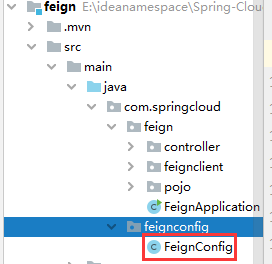Feign简介
Feign是一个声明式的Web服务客户端。这使得Web服务客户端的写入更加方便,要使用Feign创建一个界面并对其进行注释。它具有可插入注释支持,包括Feign注释和JAX-RS注释。Feign还支持可插拔编码器和解码器。Spring Cloud增加了对Spring MVC注释的支持,并使用Spring Web中默认使用的HttpMessageConverters。Spring Cloud集成Ribbon和Eureka以在使用Feign时提供负载均衡的http客户端。
Feign使用
pom依赖
<!-- Feign -->
<dependency>
<groupId>org.springframework.cloud</groupId>
<artifactId>spring-cloud-starter-openfeign</artifactId>
</dependency>
<!-- eureka-client -->
<dependency>
<groupId>org.springframework.cloud</groupId>
<artifactId>spring-cloud-starter-netflix-eureka-client</artifactId>
</dependency>
<dependency>
<groupId>org.springframework.boot</groupId>
<artifactId>spring-boot-starter-actuator</artifactId>
</dependency>
application.yml
server:
port: 9095
spring:
application:
name: feign
eureka:
client:
service-url:
defaultZone: http://root:123456@localhost:10000/eureka/
启动类添加注解
@EnableEurekaClient
@EnableFeignClients //使用Feign
@SpringBootApplication
public class FeignApplication {
public static void main(String[] args) {SpringApplication.run(FeignApplication.class, args);}
}
新建接口
@FeignClient("provider") //添加服务提供者的项目名
public interface IFeignClient {
@GetMapping("/user/{id}") //get请求
User getUser(@PathVariable("id") Long id);
@PostMapping("/getuserpojo") //传输复杂对象时,需要post请求
User getUserPojo(User user);
}
新建controller
@RestController
public class FeignController {
@Autowired
private IFeignClient feignClient;
@GetMapping("/user/{id}")
public User getUser(@PathVariable Long id){
return feignClient.getUser(id);
}
@GetMapping("/getuserpojo")
public User getUserPojo(User user){
return feignClient.getUserPojo(user);
}
}
服务提供者controller
@RestController
public class ProviderController {
@GetMapping("/user/{id}")
public User getUser(@PathVariable Long id){
return new User(id);
}
//这里要post请求,与调用端一致,因为是传输复杂对象,并且需要加上@RequestBody
@RequestMapping(value = "/getuserpojo",method = RequestMethod.POST)
public User getUserPojo(@RequestBody User user){
//返回传过来的user
return user;
}
}
启动测试
1.启动EurekaServer
2.启动服务提供者,注册到Eureka
3.启动消费者,测试controller,测试调用服务提供者
里面的user信息,是在服务提供者里写死的。


自定义配置Feign
在FeignClient注解上加上configuration参数并制定配置类
@FeignClient(name = "stores", configuration = FeignConfig.class)
也可以使用占位符来读取yml文件
@FeignClient(name = "${feign.name}", url = "${feign.url}")
这个配置类,和ribbon一样,不能被扫描到,所以放到另外的包里。
配置类

@Configuration
public class FeignConfig {
@Bean
public Contract feignContract() {
return new feign.Contract.Default();
}
}
IFeignClient接口
//指定服务名,指定配置类
@FeignClient(name = "provider",configuration = FeignConfig.class)
public interface IFeignClient {
//可改用Feign提供的@RequestLine组合注解
@RequestLine("GET /user/{id}") //组合注解,第一个是请求方式,第二个是参数,用空格分割
User getUser(@Param("id") Long id);//此处@PathVariable注解需要改成@Param注解,否则报错
@RequestLine("POST /getuserpojo")
User getUserPojo( User user);
}
Feign日志记录
为每个创建的Feign客户端创建一个记录器。默认情况下,记录器的名称是用于创建Feign客户端的接口的完整类名。
Feign日志记录仅响应DEBUG级别。
application.yml
server:
port: 9095
spring:
application:
name: feign
eureka:
client:
service-url:
defaultZone: http://root:123456@localhost:10000/eureka/
logging:
level:
#给指定的FeignClient接口设置日志输出级别,只有debug才会打印日志
com.springcloud.feign.feignclient.IFeignClient: DEBUG
配置类
import feign.Logger; /这里导入的是feign的logger
@Configuration
public class FeignConfig {
@Bean
public Contract feignContract() {
return new feign.Contract.Default();
}
// 配置日志输出
// NONE :不记录任何日志(默认)
// BASIC:仅记录请求方法、URL、响应状态代码以及执行时间
// HEADERS:记录BASIC级别的基础上,记录请求和响应的header
// FULL:记录请求和响应的header,body和元数据
@Bean
Logger.Level feignLoggerLevel() {
return Logger.Level.FULL;
}
}
Feign超时设置
application.yml
#全局配置
#Feign 的负载均衡底层用的就是 Ribbon
#ribbon的超时时间
ribbon:
ReadTimeout: 3000
ConnectTimeout: 3000




